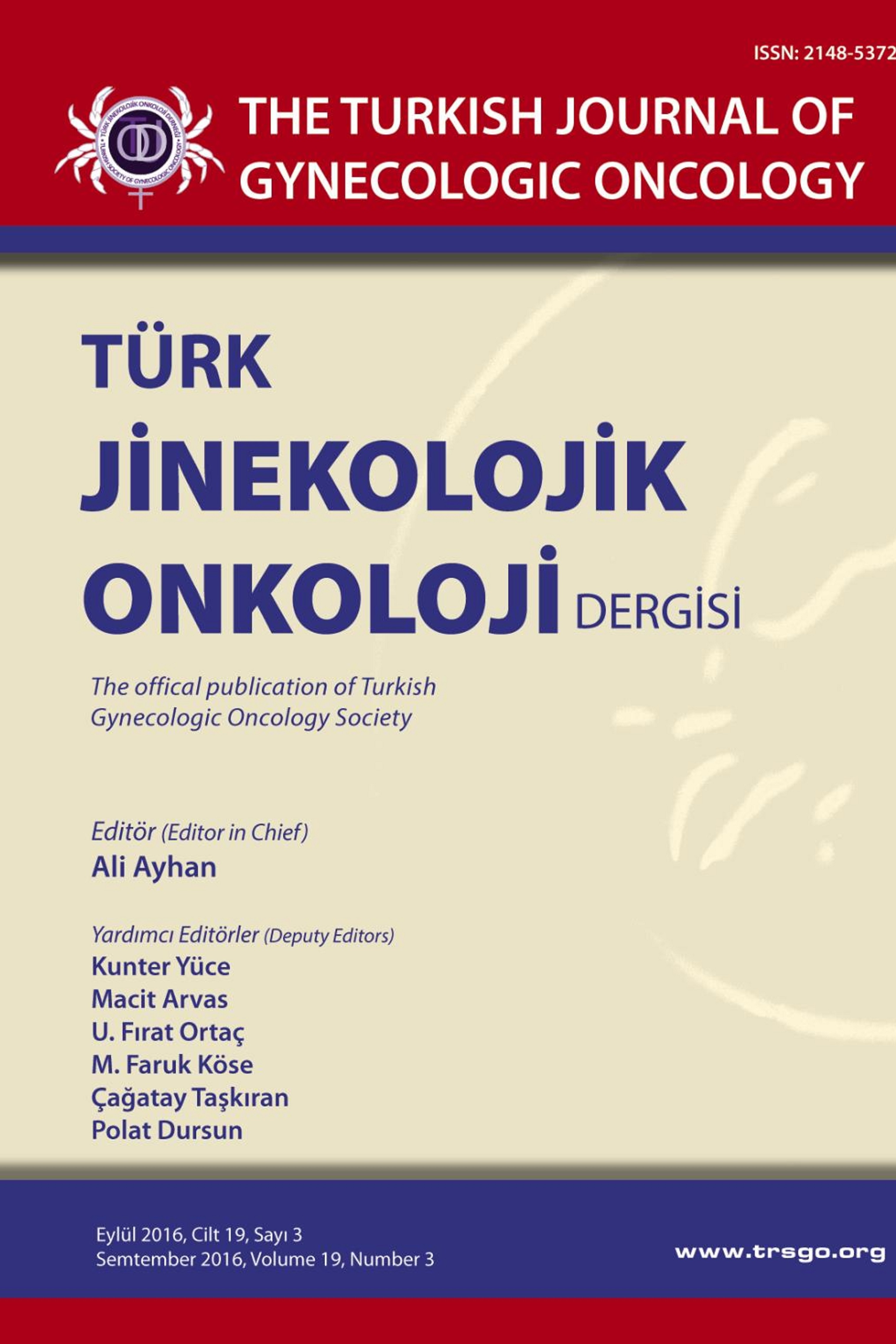RETROPERİTONEAL VE İNTRAABDOMİNAL YERLEŞİM GÖSTEREN MALİGN FİBRÖZ HİSTİOSİTOM: OLGU SUNUMU
Amaç: Pelvik kitle nedeni ile tanısal laparotomi yapılan ve kesin patoloji tanısı malign fibröz histiositom gelen bir hastada cerrahi sonrası uygulanan radyoterapi ve kemoterapinin lokal ya da uzak organ rekürrensine ve sağkalım üzerine etkilerinin bir olgu sunumu olarak tartışılması. Olgu Sunumu: Pelvik kitle tanısı ile hastaya tanısal laparotomi uygulandı. Eksplorasyonda retroperitoneal ve intrapelvik 100x100 mm boyutlarında solid kitle izlendi. Kitle çıkarılarak frozena gönderildi; frozen sonucu liposarkom olarak belirtildi. Hastaya aynı seansta kitle eksizyonu, parsiyel omentektomi, sol üreter kateterizasyonu, sol üreter çevresinden kitle eksizyonu işlemi yapıldı. Postoperatif kemoterapi alan hastanın kontrol tomografi ve ultrasonografisinde mesane anteriorunda nüks kitle saptanması üzere ikinci kez operasyona alındı. Kitle rezeksiyonu yapıldı ve işleme son verildi. Kesin patoloji tanısı Malign Fibröz Histiositom olarak gelen hastaya adjuvan radyoterapi verildi. Hasta operasyonun ikinci senesinde rekürrens olmadan sağlıklı bir şekilde yaşamını sürdürmektedir. Sonuç: Malign Fibröz Histiositom bağ dokusu kaynaklı tümöral bir dokudur. Tedavide en etkili yöntem cerrahi rezeksiyondur. Adjuvan radyoterapi lokal ve uzak organ rekürrenslerini engellemekte iken, adjuvan radyoterapi ve kemoterapinin genel sağkalım üzerinde anlamlı bir etkisi bulunmamaktadır.
Anahtar Kelimeler:
Pelvik kitle, malign fibröz histiositom, retroperiton
Objective: The purpose of this study was to evaluate the role of surgery, radiotherapy and chemotherapy in a patient diagnosed as malignant fibrous histiocytoma after explorative laparotomy for pelvic mass. Case Report: Explorative laparotomy was performed for pelvic mass, and two different masses were found one in pelvis and the other localized in the left retroperitoneal region. Both of the tumors were completely excised and diagnosed as liposarcoma intraoperatively. Since the retroperitoneal tumor invading left ureter from obturator fossa to the lower pole of the left kidney, following the excision double- J catheter was putted in. Adjuvant chemotherapy was given, but recurrent mass was found at retzius space behind the bladder. After the secondary cytoreductive surgery radiotherapy was given to this region. At the time of this writing the patient is tumor free for 2 years following the mentioned operations. Conclusion: Malignant fibrous histiocytoma originates from connective tissue. The single most efficient therapeutic approach is complete surgical cytoreduction. Although adjuvant radiotherapy decrease the local recurrence rate, neither radiotherapy nor chemotherapy has significant effect on overall survival.
Keywords:
Pelvic mass, malignant fibrous histiocytoma, retroperitoneal,
- ISSN: 2148-5372
- Başlangıç: 2014
- Yayıncı: Türk Jinekolojik Onkoloji Derneği
Sayıdaki Diğer Makaleler
PRİMER RETROPERİTONEAL TÜMÖRLER: VAKA SERİSİ
Pınar Çilesiz GÖKSEDEF, Hüsnü GÖRGEN, Murat APİ, Nida ERGİN, Ahmet ÇETİN
RETROPERİTONEAL VE İNTRAABDOMİNAL YERLEŞİM GÖSTEREN MALİGN FİBRÖZ HİSTİOSİTOM: OLGU SUNUMU
Çağatay TAŞKIRAN, Ayla AÇAR, Ercan YILMAZ, Anıl ONAN, Lütfi TUNÇ, Ömür ATAOĞLU, Haldun GÜNER
ADNEKSİAL KİTLELİ OLGULARDA PREOPERATİF TROMBOSİT VE SERUM CA-125 DÜZEYLERİNİN ANLAMI
Bülent DEMİR, Süreyya Saridaş DEMİR, Talip GÜL
OVERYAN ENDOMETRİOZİS’E SEKONDER CA-125 YÜKSEKLİĞİ
Ahmet BAŞARAN, Nilüfer Yiğit ÇELİK, Serdar GÜNALP, Ali AYHAN
